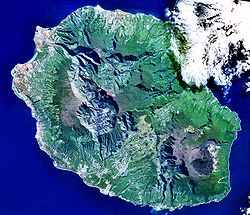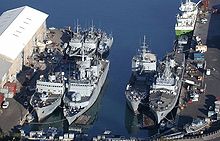Réunion: Difference between revisions
Gil Gamesh (talk | contribs) m →Demographics: Fixed ambiguous "Indian" link |
→A flag for Réunion?: Remove Image:Reunion_flag2.jpg (bad license) and fix link to Commons:Image:Flag of Réunion (Local).svg. |
||
| Line 96: | Line 96: | ||
== A flag for Réunion? == |
== A flag for Réunion? == |
||
[[Image:Reunion_flag2.jpg|thumb|An unofficial flag of Reunion]] |
|||
Although the federal period installed a number of flags of metropolitan France, Réunion does not have its own official flag. |
Although the federal period installed a number of flags of metropolitan France, Réunion does not have its own official flag. |
||
One flag was selected by the French association of [[Vexillology|vexillologists]] in [[2003]]. It depicts the [[volcano]] of [[Fournaise]], bedecked by gold sunbeams. It symbolises the appearance of populations who converged on the island at the turn of the century. |
|||
Image:Flag of Réunion (Local).svg|Proposed flag for Réunion |
Another flag is [[Commons:Image:Flag of Réunion (Local).svg|Proposed flag for Réunion]] |
||
== Notes == |
== Notes == |
||
Revision as of 00:18, 15 May 2006
Template:Infobox French Région

Réunion (French: La Réunion) is an island and overseas département (département d'outre-mer, or DOM) of France, located in the Indian Ocean east of Madagascar, about 200 km southwest of Mauritius. Like the other DOMs, Réunion is also one of the 26 régions of France with much the same status as those situated on the European mainland. As part of France, Réunion is part of the European Union, and thus the currency used is the euro [1].
History
Arab sailors used to call this island Dina Morgabin ("Western Island"). The Portuguese were the first Europeans to visit the island, finding it uninhabited in 1513, and naming it Santa Apollonia.
The island was then occupied by the French and administered from Port-Louis, Mauritius. Although the French flag was hoisted by François Cauche in 1638, Santa Apollonia was officially claimed by Jacques Pronis of France in 1642, when he deported a dozen French mutineers to the island from Madagascar. The convicts were returned to France several years later, and in 1649, the King of France Louis XIII named the island Île Bourbon after his royal house.
"Réunion" was the name given to the island in 1793 by a decree of the Convention with the fall of the House of Bourbon in France, and the name commemorates the union of revolutionaries from Marseille with the National Guard in Paris, which took place on August 10, 1792. In 1801, the island was renamed "Île Bonaparte," after Napoleon Bonaparte. The island was taken by the British navy led by Commodore Josias Rowley in 1810, who used the old name of "Bourbon." When it was restored to France by the Congress of Vienna in 1815, the island retained the name of "Bourbon" until 1848, when the fall of the restored Bourbons during the revolutions during that year meant that the island became "Réunion" once again.
From the 17th to the 19th centuries, French immigration supplemented by influxes of Africans, Chinese, Malays, and Tamil (Malabar) Indians gave the island its ethnic mix. The opening of the Suez Canal in 1869 cost the island its importance as a stopover on the East Indies trade route.
Réunion became an overseas département of France on March 19, 1946.
Between 15 and 16 March 1952, Cilaos at the center of Réunion received 1,869.9 mm (73.6 in) of rainfall. This is the greatest 24-hour precipitation total ever recorded on Earth.
In 2005 and 2006 Réunion was hit by a crippling epidemic of chikungunya, a disease spread by mosquitos. According to the BBC News[1], 255,000 people on Réunion had contracted the disease as of 26 April, 2006. The disease also spread to Madagascar[2] and to mainland France through airline travel. The disease led to more than 200 deaths on Réunion. The French government, under Prime Minister Dominique de Villepin sent an emergency aid package worth 36 million euro ($42.8 U.S. dollars) and deployed approximately 500 French troops to eradicate mosquitos.
Chikungunya means "that which bends" in Swahili. It can cause dehydration, extreme pain and high fevers and can be fatal in some cases. There is no known cure for the illness.
Politics
Main article: Politics of Réunion
Administratively, Réunion is divided into 4 arrondissements, 24 communes, and 47 cantons. It is a French overseas department as well as a French region. The low number of communes, compared to French metropolitan department of similar size and population, is an originality; most Réunionnese communes encompass several localities, sometimes separated by significant distances. Réunion is part of the Indian Ocean Commission, and has only recently joined the African Union.
Geography
Main article: Geography of Réunion

The island is 39 miles (63 kilometers) long, is 28 miles (45 kilometers) wide, and covers 970 square miles (2512 square kilometres). The island is similar to the big island of Hawaii because both are located above hotspots in the Earth's crust.
Piton de la Fournaise, a shield volcano on the eastern end of Réunion Island, rises more than 8565 feet (2611 meters) above sea level and is sometimes called a sister to Hawaiian volcanoes because of the similarity of climate and volcanic nature, has erupted more than 100 times since 1640 and is under constant monitoring. It most recently erupted on December 26, 2005. La Fournaise is created by a hot spot volcano, which also created the Piton des Neiges and the islands of Mauritius and Rodrigues.
Piton des Neiges volcano, the highest point on the island at 10069 feet (3070 meters) above sea level, is northwest of Piton de la Fournaise volcano. Collapsed calderas and canyons are southwest of the mountain. Like Mauna Kea on the big island of Hawaii, Piton des Neiges is extinct. Despite its name, snow practically never falls on the summit.
The slopes of both volcanoes are heavily forested. Cultivated land and cities like the capital city of Saint-Denis are concentrated on the surrounding coastal lowlands.
Réunion also has three calderas: the Cirque de Salazie, the Cirque de Cilaos and the Cirque de Mafate. The latter is accessible only by foot or helicopter.
Economy
Main article: Economy of Réunion
Sugar is the chief agricultural product and export, and tourism is also an important source of income.
The territory traditionally had a large gap in income and standard of living between the wealthier communities of European and Indian descent, and the poorer African and other communities. This gap is closing with time. Metropolitan France provides substantial financial support to Réunion.
Some fishermen of Réunion also derive a certain amount of revenue from shark fishing.
Demographics
Main article: Demographics of Réunion
Reunion has the same population of Malabars or Tamil, Indians (Hindu and Muslim), Vietnamese, African, Malagasy, Chinese and French as Mauritius but in different proportions. White French make up approximately one-quarter of the population.
Public health
Reunion is currently experiencing an epidemic of Chikungunya virus. As of April 6th, 2006, 230,000 people have been infected, which amounts to 29% of the population.
Culture
Main article: Culture of Réunion
See also: Music of Réunion
Reunionese culture is a blend of European, African, Tamil, Chinese and insular traditions.
The most widely spoken language, Réunion Creole, derives from French, with many idiosyncracies. Though still rare, Réunion Creole is now taught in some schools, however, an official orthography has yet to be agreed upon.
Food and music blend influences from Africa, India, China and Europe.
A flag for Réunion?
Although the federal period installed a number of flags of metropolitan France, Réunion does not have its own official flag.
One flag was selected by the French association of vexillologists in 2003. It depicts the volcano of Fournaise, bedecked by gold sunbeams. It symbolises the appearance of populations who converged on the island at the turn of the century.
Another flag is Proposed flag for Réunion
Notes
- ^ Réunion is pictured on all Euro banknotes, on the backside at the bottom of each note, right of the Greek ΕΥΡΩ (EURO) next to the denomiation.
Miscellaneous topics

- Communications in Réunion
- Communes of the Réunion département
- Military of Réunion
- Transportation in Réunion
See also
- French overseas departments and territories
- Administrative divisions of France
- Islands controlled by France in the Indian and Pacific oceans
External links

Government
Overviews
- CIA World Factbook - Reunion
- Open Directory Project - Reunion directory category
Tourism
- Template:Wikitravel
- Official Tourism web site
- Images of Reunion
- WillGoTo - Réunion Travel Guide and Directory
- Lonely Planet - World Guide: Reunion
- Pearl Island probably the only English website from the island about the island
Public health
- Information about the Chikungunya viral epidemic on the island
- BBC article about French government action against the Chikungunya virus
Fauna - Flora
Other

